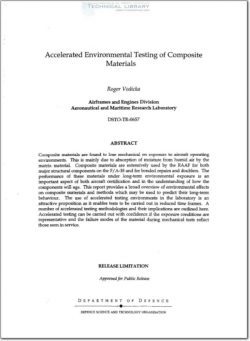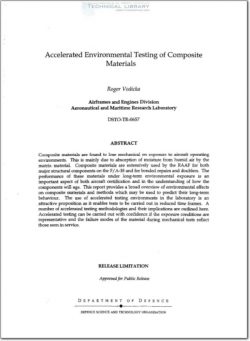DSTO-TR-0657

- Version
- 240 Downloads
- 4.54 MB File Size
- 1 File Count
- August 10, 2016 Create Date
- August 10, 2016 Last Updated
Accelerated Environmental Testing of Composite Materials

This report addresses material durability and strength issues for composite materials
in RAAF aircraft operating under Australian climatic conditions. The effects of the
natural environment during both flight and ground storage are assessed. Methods
which may be used to simulate these effects in the laboratory in shorter time frames
are outlined. Such information may be vital in formulating life-extension strategies and
anticipating material problems well in advance. This report does not address issues
related to corrosion or the effects of chemical acfiOn on materials such as fuels or
hydraulic fluids.
The environmental conditioning of composite materials is an important aspect of their
certification for use in aircraft structures. The mechanical properties of composite
materials such as boron/ epoxy and graphite/ epoxy degrade in the natural
environment and particularly under hot/ wet conditions. It is important to understand
these effects in order to design confidently and Certify composite structures. There are
numerous mechanisms which act to degrade the matrix and in some cases, the fibre
itself. Changes in material properties over time may also need to be quantified. This
can be difficult since real-time environmental testing of a composite in a natural
environment may take many years to complete.
Both graphite / epoxy and boron/ epoxy materials are currently used by the RAAF on a
number of aircraft. Boron/ epoxy material is primarily used in adhesively bonded
repairs or reinforcements such as on the F~111 upper wing—pivot fitting. Large
boron/ epoxy doublers were also fitted to the lower wing pivot fitting during original
manufacture. Graphite / epoxy material is used extensively on the surfaces of the F/ A-
18 aircraft such as the main wing skins, horizontal stabilator and vertical fins.
Understanding the way in which these materials will perform in the future is vital
knowledge for the supportability of the RAAF fleet.
Creating accelerated testing environments which replicate the effects of long-term
natural environmental exposure and flight mission profiles can significantly reduce
testing time and give advance warning of material problems which may arise in the
future. It must be stressed that such tests must be carried out carefully to avoid
exposing the material to conditions it may never see in service. It is therefore
important to accurately define the conditions the material will be exposed to in the first
place.
| File | Action |
|---|---|
| DSTO-TR-0657 Accelerated Environmental Testing of Composite Materials.pdf | Download |

Comment On This Post